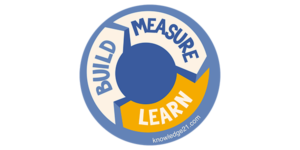After Eric Ries published his book The Lean Startup in 2011, the term Minimum Viable Product (MVP) became popular. Numerous companies started to adopt it to develop their products.
However, when a term becomes very popular, it turns into a buzzword, a slogan that people use to change the original idea so much that it retains little if any of its original concept.
What MVP (Minimum Viable Product) is
“The MVP is that version of the product that enables a full turn of the Build-Measure-Learn loop with a minimum amount of effort and the least amount of development time. The minimum viable product lacks many features that may prove essential later on.” (The Lean Startup, Eric Ries, 2011)

The primary goal of an MVP is to validate or invalidate as fast as possible a hypothesis for the solution of a business problem.
An essential point about MVP is that it isn’t a product just knocked together, lacking in quality, which might “break” on first use. It’s a lean product, but complete.
If the MVP is given to consumers, they’ll get the same quality level as the final product. But since its goal is to test a hypothesis, it’ll by necessity not have all the functions of a final product.
What if the business hypothesis is invalidated? In his book, Eric Ries talks about pivoting and discarding ideas.
If you want to know more about this and experiment with a full cycle of invalidation of ideas, take part in our Certified Scrum Product Owner (CSPO) training.
Examples of MVP (Minimum Viable Product)
Here are three cases of fair use of MVP. There are plenty of others, but I found these really interesting.
EasyTaxi
During the QCon in Rio de Janeiro, Brazil, in 2015, Vinícius Gracia presented the case of Easy Taxi and how they used MVP to validate their hypotheses. Their first hypothesis they had was: will people order a taxi via a cell phone app? They built a minimum app on which people could order a taxi in Rio de Janeiro.

One crucial detail was that only the app interface was developed. Whenever anyone made a request, the Easy partners got an alert and quickly used the phone of a taxi cooperative near the user and order them a taxi.
When the number of orders reached a number they considered reasonable, and they declared the hypothesis validated and proceeded with the product’s development.
Goat Simulator
Imagine you’re the director of a company making electronic games. One of your developers comes to you and says: Boss, let’s develop a simulation game along the lines of GTA (Grand Theft Auto). Only instead of a person, it’ll be a goat living as a goat.

Initially, it might sound like a ridiculous idea. As a manager, you can quickly turn him down or turn it into a business idea: Will people enjoy living like a goat in a virtual world?
In 2014, Armin Ibrisagic, of Coffee Stain Studio decided to spend a month building the minimum needed to have a game in which the player simulated being a goat going through various adventures and mishaps. He uploaded a few videos to YouTube and followed how many times the video was seen, how many likes, shares, and comments.
When it hit a specific number, Armin felt confident enough to build the full game. If you thought the original idea a lousy one, know that the game was launched on April 1st (the irony of ironies) and by August, had sold over a million copies at the unit price of US$ 13.00.
The game is sold to this day (2019) at US$ 9.99 apiece and has been carried over to consoles like Xbox One, Playstation 3 and 4, Nintendo Switch, and PC, as well as physical copies sold in stores. More about this story in this link.
Plugmeter
Have you noticed your electricity bill suddenly going up? Wouldn’t you like to find out which appliance is the main culprit of energy consumption in your home? Based on these questions, a group of Computer Science students at the Federal University of Rio de Janeiro (UFRJ) decided to create a product to resolve this issue precisely.
The Plugmeter was a gadget that worked as an extension linked to the electricity network. You plugged in the appliance you wanted to test, and it told you how much it was using every hour it was left on.
However, building such a product would be costly, and they didn’t know whether people would be interested in buying them. So they created an elementary page with an image of the “product” made using Photoshop and a “buy here” button.
When people clicked, it just recorded the name and e-mail for their future interest. They invested US$ 20.00 in Facebook Ads and measured how many people clicked on the “buy here” button and filled out the form showing interest.
In a week, the button had been clicked on, and hundreds of people had filled out the form. With the hypothesis validated, they proceeded with building the product. A full account of the case can be found at this link.
What MVP (Minimum Viable Product) isn’t
Unfortunately, over time the term has been lost, and many companies are out of touch with the original concept. I’ve seen places using a cycle of three to six weeks to produce an MVP. That’s a long time to validate a hypothesis. Let’s see what MVP isn’t.
Prototype
Usually, a prototype is made to test a product’s characteristics. Once these characteristics are validated, the prototype is discarded, and the product is built, taking into account the results from the prototype.
But MVP isn’t supposed to be discarded after the experiment. You can test other hypotheses, evolve it, and it can become your final product.
Project phase
Many companies treat MVP as the phase of a project with a well-defined model of deliveries. In the first quarter, we’ll deliver MVP 1, in the second MVP 2, the third MVP 3, and the fourth quarter MVP 4.
This isn’t an MVP. These are phases of a product which probably has a closed scope. In these cases, there aren’t any hypotheses being tested every three months. Just certainties.
Long
Following on from the previous sub-item, an MVP shouldn’t take long. If it does, it either means you only have certainties or want to validate too many hypotheses at once. It goes against the scientific method of an Experiment.
The MVP should test the most significant risk hypothesis that can totally invalidate your product—one at a time. Remember, you don’t need to release it to all your clients at once. You can choose a statistically significant group and make the MVP available to them while you collect metrics and test your hypothesis.
Finished product
Clearly, the MVP isn’t the first version of a product. If everyone is proud of the product being delivered because it’s complete, that’s a bad sign. You’ve probably built too much, and your product might not initially get the expected return.
Metric-less product
If you want to validate a hypothesis, what numbers prove your MVP has been successful or a failure? The number of clients gained, retained, purchases made, churn, forms of use, satisfaction. Everything should be measured in an MVP; otherwise, you’ll have an experiment that can’t be validated.
Conclusion
In this article, we’ve presented what an MVP is, given a few examples, and talked about a few misconceptions we find in the market.
Once again, I’d like to invite you to take part in our CSPO training, where you’ll learn and try out the Build, Measure, and Learn loop, as well as find out about various techniques for becoming a good Product Owner.
I’d also like to invite you to our Agile Metrics training for Products, Teams, and Organizations, where you’ll learn about the metrics you’ll need to measure your MVP.
